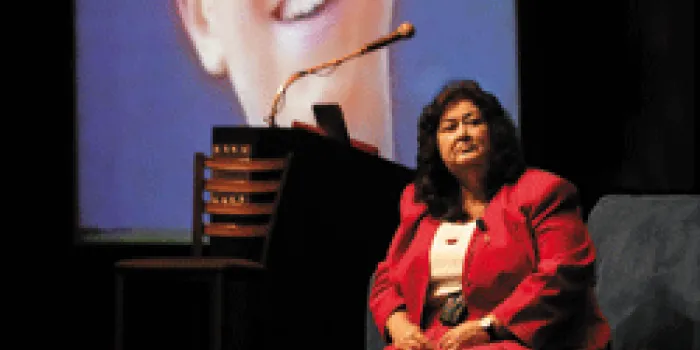Most teenagers don’t share a piano bench with Elton John during a concert. Or drive a red Mustang, a gift from Michael Jackson. Or win the hearts of former presidents. Then again, Ryan White was not like most teenagers.
Ryan was 13 when he was diagnosed with AIDS in 1984, a result of contaminated factor infusions he had received to treat his severe hemophilia A. With fortitude, the teenager from Kokomo, Indiana, helped normalize AIDS, a dreaded disease. Ryan did not return blow for blow, even when kids taunted him and adults treated him like a leper. Instead, he identified their underlying fear and ignorance, remedying them through education. “He chose to fight the disease and not the people,” says his mother, Jeanne White-Ginder, 67, of Leesburg, Florida.
This year marks the 30th anniversary of Ryan’s AIDS diagnosis. It’s an appropriate time to remember him and review his accomplishments in advocating for people with AIDS.
Early years
Ryan was diagnosed with hemophilia days after his birth on December 6, 1971. With no family history of the disease, his mother was understandably anxious. “They told me Ryan could never play contact sports or have any major surgeries,” Jeanne recalls. A car accident that caused hemorrhaging could kill him, warned doctors.
This gloomy news was met with a ray of hope. An experimental factor VIII (FVIII) drug was available, although not yet approved by the US Food and Drug Administration. “We feel it’s going to allow people with hemophilia to live almost a normal life,” Ryan’s hematologist told his mother, Jeanne says. The Whites signed a consent form to have FVIII administered by hospital staff.
In the early 1970s, freeze-dried factor concentrates, from the pooled plasma of thousands of blood donors, made life more manageable for families coping with hemophilia. The unimaginable, though, was lurking in those products—viruses that would cause the hepatitis and HIV epidemics that devastated an entire generation.
School days
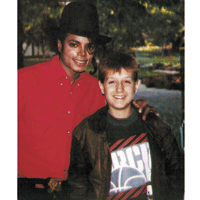
Ryan poses with pop superstar
Michael Jackson.
Growing up, Ryan was funny, happy and creative. “He had an imagination,” Jeanne says. Whatever he dreamed up, his younger sister, Andrea, joined in.
Jeanne impressed on Ryan that education was his ticket to the future. “He loved school,” says Jeanne. “He loved math.” He also loved the news. “He asked his grandparents for a subscription to Time magazine when he was 9 years old,” says Jeanne, laughing. Ryan’s familiarity with the making of a good story made him a hit with the media years later.
At school, Ryan kept his hemophilia diagnosis under wraps. Returning to classes after a joint bleed required a bit of acting. “He would try his darnedest not to limp, because the kids all made fun of him,” Jeanne says.
Trying times
Symptoms of Ryan’s compromised health peaked in 1984. “I kept taking him to the doctor, and he said there were a lot of colds and flus going around,” Jeanne says. After his hemophilia treatment center clinic visit in November, Jeanne’s phone rang. “Are you aware that Ryan has hepatitis?” the doctor asked.
A few days after Ryan’s 13th birthday in December, he pleaded with Jeanne. “Mom, you’ve got to do something,” he cried. “I can’t even get off the school bus without being tired.” A high fever later that week landed Ryan in a local hospital, where he was diagnosed with bacterial pneumonia. The staff pounded on his chest to break up the fluid in his lungs. “Mom, there’s nothing down there to cough up,” Ryan said, exhausted.
Ryan was then transferred to Riley Hospital for Children in Indianapolis, where a portion of his lung was surgically removed. Martin B. Kleiman, MD, head of the infectious diseases department, suspected Ryan had TB, cancer or AIDS. “That’s the first time I ever heard the word AIDS,” Jeanne says.
A biopsy revealed the presence of Pneumocystis carinii, a rare pneumonia that confirmed AIDS. The prognosis was grim. Ryan had 3 to 6 months to live.
His T cell count, an indicator of immune function, was 25 (500–1,200 is normal). “It never changed,” says Jeanne. “But Ryan lived another 5½ years, which everybody finds almost impossible.”
Private Ryan
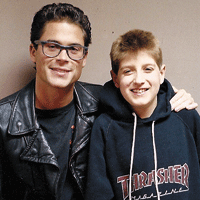
Rob Lowe hangs out with Ryan.
When teachers came to the hospital with get-well cards and letters, Jeanne suggested they don gloves and gowns, mostly to protect Ryan. “They say he has AIDS, but I think they’re going to find out it’s something else,” she said offhandedly. The teachers looked alarmed. “I really saw it then—I saw the panic,” says Jeanne. “It made me kind of worry.”
Before Ryan’s AIDS diagnosis leaked to the public, Kleiman urged Jeanne to tell her son. A few days after Christmas 1984, Jeanne disclosed Ryan’s diagnosis. “Am I going to die?” he asked. He begged his family to pretend he didn’t have AIDS. Ryan did not want people’s pity. “I just want to go on and go ahead with my life,” he said.
During his month-long hospital stay, Ryan had an epiphany. “Mom, the Lord just came and spoke to me,” he said one day. “He told me I had nothing to fear, that I was going to be taken care of.” After that, Ryan had an inner peace, Jeanne says.
Acceptance and information
But Jeanne was far from peaceful. “Every cough, every fever, I worried about whether it was going to be the last,” she says. She questioned everything, but lacked answers. “I want to know all there is to know about this disease,” Jeanne told Kleiman. He recommended the newly formed American Foundation for AIDS Research (amfAR) in New York. “The people who are fighting this disease now and trying to do something about it are mostly the gay community,” Kleiman told Jeanne at the time. From the start, the Whites were embraced by the community. “I needed people, and I felt the comfort,” Jeanne said.
As Ryan’s story made the headlines, sympathetic supporters surfaced. Elton John flew the Whites to California to attend his concerts and enjoy a day at Disneyland. Rob Lowe took Ryan shopping for sunglasses. Former President Ronald Reagan invited Ryan to his home.
Invaluable legal aid came from Charles Vaughan Sr., an Indiana attorney. “Do you really want to go to school that bad?” he asked Ryan. “It could get ugly.” Ryan answered, “I can take it.” In August 1985, Vaughan filed a lawsuit in the US District Court in Indianapolis for Ryan to be readmitted to school.
As the court case dragged on for months, Ryan pressed on. “The teachers think they’re going to prolong this in the courts, but they better not hold their breath,” Ryan told Jeanne. “They think I’m going to die, but I’m going to get to go back to school.” Seeing her son’s feistiness bolstered Jeanne. “It gave him a purpose to live,” she says.
A tale of two schools
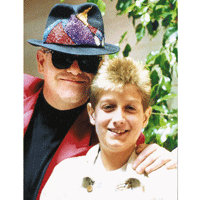
Elton John befriends Ryan and
later establishes the Elton John
AIDS Foundation.
Ryan wanted to be like any other teenager—to go to school, have friends and blend in. But the treatment he got at his middle school prevented that. The fear that AIDS could spread through casual contact was still widespread. So when Ryan returned to school in February 1986, half the students stayed home. He was not allowed to take PE, and he had to use separate drinking fountains and bathrooms. His locker was vandalized, and students jeered and teased him in the halls.
The community also ostracized Ryan. Restaurants discarded his used dishes. Church members refused to shake his hand. The final straw was a bullet through the living room window. “Whatever I do, I’ve got to try to make our life better,” Jeanne vowed.
In 1987, the family moved to Cicero, Indiana, for a fresh start. “I don’t think there’ll be as much prejudice there,” the real estate agent said. During the Whites’ first day in their new home, several teens and mothers stopped by to welcome them. “It was so different already,” Jeanne says. “It was like night and day.”
Ryan had friends at his new high school, worked at Maui Skateboard Shop and went to prom. “He was thriving,” Jeanne says. “He just had so much support from the kids at school.” Ryan recognized it, too. “Mom, for the first time I’ve got other people fighting this disease with me,” he said.
AIDS advocacy
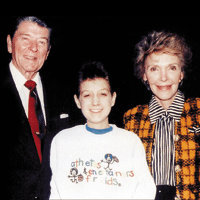
Ryan’s work as an AIDS and hemophilia
advocate allowed him to meet many people,
including former President Ronald Reagan
and First Lady Nancy Reagan.
In April 1986, Ryan co-hosted the first amfAR AIDS benefit in New York, sharing the limelight with Elizabeth Taylor, amfAR co-founder. During the next few years, Ryan co-hosted several other AIDS benefits, including some for children.
Soon Ryan became a spokesperson for AIDS awareness and education. The discrimination he endured and his determination to return to school made him a sought-after guest on television talk shows and news programs, and in feature stories in newspapers and magazines. As his plight unfolded in the national media, Ryan never changed. “He was the same on camera and off camera,” Jeanne says.
When Ryan was 16, he testified before the President’s Commission on AIDS. “Because of the lack of education on AIDS, discrimination, fear, panic and lies surrounded me,” he said about his treatment at the middle school. The family move had made all the difference. “My life is better now. I’m just one of the kids, and all because the students at Hamilton Heights High School listened to the facts, educated their parents and themselves and believed in me.”
When The Ryan White Story, a made-for-TV movie, aired on ABC in January 1989, 15 million viewers tuned in. At the time, people with AIDS were still treated as pariahs. The Whites’ judgment in making their story public was questioned. “I didn’t think to hide or that I had anything to be ashamed of, either,” says Jeanne. “Let’s make it a disease and not a dirty word,” was Ryan’s response.
Ryan’s legacy

Ryan receives a red Mustang from
Michael Jackson.
By the spring of 1990, AIDS was ravaging Ryan’s body. He was hospitalized in April, suffering from internal hemorrhaging and kidney failure. Elton John was there with Jeanne during Ryan’s last 10 days. “He’s the one who told me to let go,” Jeanne says. Ryan died on April 8, 1990, Palm Sunday.
But Ryan’s legacy lived on. Sen. Orrin Hatch (R-UT) called Jeanne, inviting her to Capitol Hill for a meeting with 25 senators needed as co-sponsors of the Ryan White Comprehensive AIDS Resources Emergency Act. He and Sen. Ted Kennedy (D-MA), the original sponsor, were champions of the bill. “Tell them what it was like for a mom to watch her son live and die from AIDS,” Hatch told Jeanne back then. “This is the time we can really touch the hearts and get something done for people with AIDS.”
Two weeks after Ryan’s funeral, Jeanne spoke to the senators. The bill passed both houses by a large margin and was enacted August 18, 1990. Renamed the Ryan White HIV/AIDS Program, it is the largest federally funded program for people with HIV/AIDS. In the past 20 years, funding has skyrocketed from $220 million to $2.29 billion. The program provides care to more than 500,000 people annually through community-based service organizations, health departments and clinics. “I never realized how enormous that bill would become,” Jeanne says.
Nearly 25 years after Ryan’s death, the impact of his life is still being felt. Contributors can donate to the Elton John AIDS Foundation, which has given $300 million in grants for AIDS prevention and treatment. Visitors can experience “The Power of Children,” a permanent exhibit at the Children’s Museum Indianapolis that displays Ryan’s bedroom and provides education on HIV/AIDS.
But Jeanne is proudest of the federal program that bears her son’s name. “What’s the best way for Ryan to be remembered and his legacy to continue?” she asks. “Helping other people live with AIDS.”

